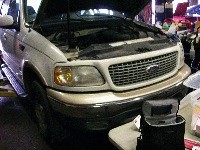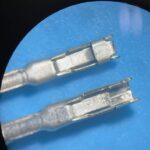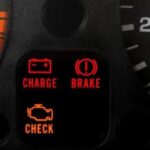Modern vehicles are equipped with sophisticated fuel management systems that constantly monitor and adjust for optimal performance and emissions. Understanding your car’s Fuel Status Obd2 readings is crucial for effective diagnostics and maintenance. Gone are the days of simply knowing “open loop” and “closed loop.” Today’s systems provide a more nuanced look into fuel system operation. This article will delve into the definitions of modern fuel system statuses as reported by OBD2 systems, helping you interpret these readings and diagnose potential issues.
Understanding Open Loop Operation
In the simplest terms, “open loop” operation signifies that the engine control unit (ECU) is not using feedback from the oxygen sensor to control the air-fuel mixture. When an engine is first started, especially when cold, or if an oxygen sensor malfunctions, the system enters open loop.
During open loop, the ECU relies on pre-programmed maps and readings from other sensors like the coolant temperature sensor and mass airflow sensor to determine the fuel mixture. As automotive expert Larry Carley explains, “when no signal is received from the O2 sensor… the computer orders a fixed (unchanging) rich fuel mixture.” This richer mixture is essential for cold starts and rapid engine warm-up but is less efficient and produces higher emissions compared to closed loop operation.
Alt text: A detailed view of an Engine Control Unit (ECU) highlighting its role in regulating the fuel mixture in a modern vehicle, crucial for understanding fuel status OBD2.
Closed Loop: Utilizing Oxygen Sensor Feedback
Once the engine and oxygen sensor reach their operating temperatures, the system transitions to “closed loop.” In this mode, the oxygen sensor becomes an active participant in fuel control. Closed loop operation is characterized by the ECU actively using the oxygen sensor’s input to fine-tune the air-fuel ratio.
Carley further elaborates, “The computer uses the oxygen sensor input to regulate the fuel mixture, which is referred to as the fuel ‘feedback control loop.’” The ECU continuously adjusts the fuel mixture based on the oxygen sensor readings, aiming for the ideal stoichiometric ratio. This results in a constant oscillation between slightly rich and lean mixtures, which is essential for the catalytic converter to operate at peak efficiency and minimize emissions. This dynamic adjustment is what makes closed loop operation efficient and environmentally friendly.
Closed Loop Fault: A Problem within Feedback Control
The “closed loop fault” status indicates that while the system is still attempting to operate in closed loop, the ECU has detected a problem, typically related to the upstream oxygen sensor(s). This fault could arise from a sensor that is consistently reading high or low, or it might be triggered by misfire events.
Even with a closed loop fault, the system remains in closed loop operation, striving to maintain fuel feedback control. However, the “fault” flag is a critical diagnostic indicator, signaling that there’s an issue affecting the fuel system’s ability to regulate mixture effectively. It’s a crucial clue that demands further investigation to ensure optimal engine performance and emissions control and is a key aspect of interpreting fuel status OBD2 readings.
Open Loop Fault: When the System Defaults to Protection Mode
Finally, “open loop fault” is triggered when the ECU detects a significant issue with the upstream oxygen sensors, often indicated by lean or rich codes (like P0171 or P0174). In this scenario, the system abandons closed loop operation and reverts to open loop.
The key difference between “open loop fault” and simple “open loop” is the presence of a diagnosed problem. In “open loop fault,” the system is not just operating without oxygen sensor feedback due to engine temperature; it’s actively avoiding feedback control because of a detected sensor malfunction or other serious fuel mixture issue. The primary objective in “open loop fault” is catalytic converter protection, even if it means less efficient fuel consumption and potentially increased emissions. This status clearly signals a problem requiring immediate attention within the fuel status OBD2 system.
Case Study: Diagnosing Open Loop Fault on a Ford Expedition
To illustrate these concepts, let’s examine a diagnostic case on a 1999 Ford Expedition experiencing open loop fault, as indicated by OBD2 codes P0171, P0174, P1131, and P1151.
Initial Observation and KOER Test:
Upon starting the vehicle and reviewing PID data, it was noted that both upstream oxygen sensors were reading a fixed 1.66 volts even when the engine was cold. After warming up and entering what should have been closed loop, the sensors remained below 0.5 volts and the fuel system status transitioned to “open loop fault.” A KOER (Key On Engine Running) self-test confirmed “On Demand Codes” P1131 and P1151, with descriptors indicating a “lack of switching” from the upstream oxygen sensors.
Fuel System Checks:
Suspecting a fuel delivery issue, the technician performed tests on fuel pressure, volume, and pump amperage. The results were:
- Fuel Pressure: 25 psi
- Fuel Volume: 0.7 gallons/minute
- Fuel Pump Current: 6.2 amps
These readings were within specifications, ruling out a general fuel delivery problem. The fuel filter was preemptively replaced, but this did not resolve the issue.
Oxygen Sensor Analysis and BARO PID Check:
Further PID data review revealed a BARO (Barometric Pressure) reading of 146.8 Hertz. For this Ford model year, BARO readings are inferred from the MAF (Mass Air Flow) sensor. An incorrect MAF reading can lead to inaccurate BARO values. The observed BARO reading suggested an altitude of approximately 4,000 feet above sea level, which was incorrect for the vehicle’s location.
Alt text: A scan tool displaying live data, specifically oxygen sensor readings during a diagnostic test for fuel status OBD2, showing lack of sensor switching activity.
MAF Sensor Replacement and KAM Reset:
Based on the BARO reading anomaly, the technician suspected a faulty MAF sensor. The MAF sensor was replaced, and a KAM (Keep Alive Memory) reset was performed to clear learned fuel trims and allow the system to relearn.
Post-Repair Evaluation and Hard Acceleration Tests:
After the KAM reset, the vehicle was driven, and BARO readings were monitored. Initially, the BARO reading was 149.7 Hz after the reset. However, during subsequent hard accelerations, the BARO reading did not increase as expected. Furthermore, the oxygen sensors still showed no switching activity during closed loop operation.
Alt text: Scan tool interface displaying fuel system data post-repair, including BARO readings after KAM reset, used in fuel status OBD2 diagnostics to assess system response.
Final Diagnosis: Oxygen Sensor Replacement:
Despite replacing the MAF sensor, the lack of oxygen sensor switching remained. After confirming proper power, ground, and connections to the sensors, it was concluded that both upstream oxygen sensors were faulty and needed replacement.
Following the replacement of both oxygen sensors, a final KOER self-test was performed. The oxygen sensors now exhibited normal switching activity, and the fault codes were resolved. The fuel system status returned to normal closed loop operation when appropriate.
Conclusion: The Importance of Understanding Fuel Status OBD2
This case study demonstrates the importance of understanding the nuances of fuel status OBD2 readings beyond simple open and closed loop. “Closed loop fault” and “open loop fault” statuses provide critical insights into the nature of fuel system issues. By correctly interpreting these statuses and utilizing diagnostic procedures, technicians can effectively pinpoint problems and ensure optimal engine performance and emissions control. Understanding these fuel system definitions is essential for anyone involved in modern automotive diagnostics.
Is it possible for two oxygen sensors to fail simultaneously? Share your thoughts and experiences in the comments below!


